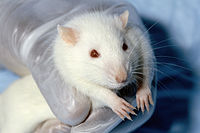
Photo from wikipedia
Oocyte cryopreservation is an important technology in assisted reproduction and fertility preservation. However, the developmental potential of cryopreserved oocyte remains poor. Osmotic stress injury (OSI) during cryoprotectants (CPAs) loading and… Click to show full abstract
Oocyte cryopreservation is an important technology in assisted reproduction and fertility preservation. However, the developmental potential of cryopreserved oocyte remains poor. Osmotic stress injury (OSI) during cryoprotectants (CPAs) loading and unloading steps has critical impact on successful cryopreservation. In order to minimize OSI to oocytes, a microfluidic device was designed and fabricated to achieve continuous CPA concentration change. MII porcine oocytes were loaded and unloaded CPAs with step-wise and microfluidic methods, oocyte volume changes were recorded and compared, loading and unloading duration of microfluidic methods were optimized. The survival and developmental rate of treated oocytes in step-wise and microfluidic linear methods were also evaluated. The results showed that oocyte volume changes with microfluidic method were obviously less than step-wise method, and the survival, cleavage and blastocyst rate of oocytes were 95.3%, 64.4%, and 19.4%, respectively, which were significantly higher than the traditional step-wise method (79.4%, 43.6%, and 9.7%) (p < 0.05). In conclusion, microfluidic device can effectively reduce the osmotic damage to oocytes and improve the survival rate and developmental rate of oocytes, which may provide a new path for oocyte cryopreservation.
Journal Title: Cryobiology
Year Published: 2019
Link to full text (if available)
Share on Social Media: Sign Up to like & get
recommendations!